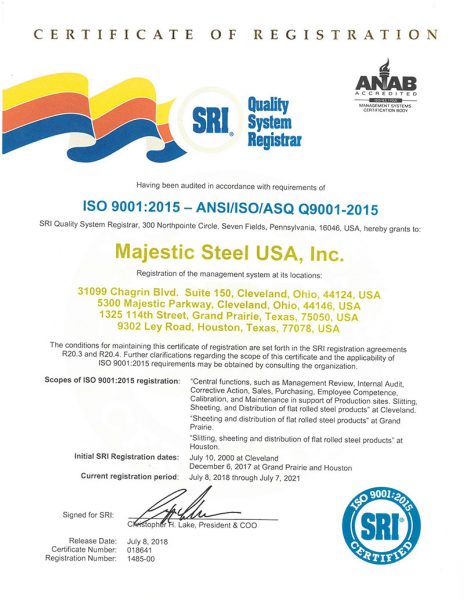Market Update | December 20, 2023
NIPPON STEEL TO BUY U.S. STEEL
Japanese steel producer, Nippon Steel, announced that they would buy U.S. Steel in a deal valued at $14.9 billion. Nippon is not completely foreign to the U.S. market as they have a joint venture with AMUSA in Calvert. Since 2020, Wheeling-Nippon has also fallen under the Nippon Steel Corp’s umbrella.
Input Costs
As the recent up and down movement for zinc continues, pricing rebounded this week.
- Zinc pricing came in at $1.17/lb this week, up from $1.11/lb previously and remains right near the 30-day average.
Spot iron ore pricing was virtually flat again this week, holding around $140/mt.
- This is down less than 1% from the end of last week.
Pacific Basin met coal pricing declined this week, sliding to $315/mt.
- Current pricing is down 6.0% from the end of last week and is down 3.6% from this time last month.
Supply
Japanese steel producer, Nippon Steel, announced that they would buy U.S. Steel in a deal valued at $14.9 billion.
-
- Nippon is not completely foreign to the U.S. market as they have a joint venture with AMUSA in Calvert.
- Since 2020, Wheeling-Nippon has also fallen under the Nippon Steel Corp’s umbrella.
U.S. raw steel production increased last week, climbing to an eleven-week high.
-
- U.S. steelmakers produced 1.714 million tons at a 74.6% utilization rate.
- Year-to-date production was 85.4 million st, remain virtually flat from last year.
- U.S. steelmakers produced 1.714 million tons at a 74.6% utilization rate.
Preliminary December imports (17 days) increased sharply compared to November, climbing about 25% mtd.
-
- An increase in December would stop a string of five consecutive monthly declines.
- HDG sheet imports are on pace for a 10% m/m increase.
Inventory came in at 3.890 million tons, down 3.1% y/y, and down for the 15th consecutive month with a y/y decline.
-
- Inventory on hand fell below 3.900 million for second straight month and at the third lowest total since July 2021.
- Months of Supply – 1.81 months, is up from October and slightly higher than the YTD average of 1.75 months.
- Days of Supply – 36.3, is up from 35.9 in October but well below historical November levels.
- Average days of supply for the last 8 November’s is 2.11 months.
- On order – 3.279 million tons, is down from 3.408 million tons in October.
- Potential Months of Supply – 3.34 months, is up slightly from October and highest level since last December.
- However, on tonnage basis (inventory + on order) was down from October; 7.169 million tons vs 7.246 million tons.
DEMAND
Confidence among U.S. homebuilders improved from November but remained in negative territory once again.
- This was the first improvement after four consecutive declines.
- The December Housing Market Index came in at 37, up from 34 in November but still well below 50.
- Any reading under 50 indicates increased pessimism, while any reading over 50 indicates increased optimism.
- While the present situation component remained flat at 40, the next six months component increased by 6 points to 45
- Looking at the three-month moving averages for regional HMI scores, the Northeast increased two points to 51, the Midwest fell one point to 34, the South dropped three points to 39, and the West posted a four-point decline to 31.
- Lower mortgage rates and improved economic data have builders feeling more optimistic heading into 2024.
New residential construction pushed higher once again in November, now up for the third consecutive month.
- New housing starts came in at a 1.560-million-unit rate, up 14.8% from October and up 9.3% from 1.427-million-unit rate in November 2022.
- This was the first y/y increase since July and the largest y/y increase since March 2022.
- Year-to-date actual starts are still down 9.9% compared to the same timeframe last year.
- Permits, a leading indicator for future construction, slipped slightly to a 1.460-million-unit rate.
- This is down 2.5% from October but up 4.1% from last November
After sliding the previous five months, sales of existing homes increased slightly in November.
- November existing home sales came in at a 3.820-million-unit rate, up 0.8% from October but were still down 7.3% from the 4.120-million-unit rate in November 2022.
- Existing home sales have now declined, on a year-over-year basis, for twenty-seven consecutive months.
- However, November marks the lowest y/y decline since April 2022.
- At the end of November, the inventory of existing homes for sale totaled 1.130 million.
- This is down 1.7% from October but up 0.9% from 1.120 million units in November 2022.
- The current inventory, when combined with November’s sales pace, equates to 3.5 months of supply.
ECONOMIC
Confidence from the U.S. consumer continued to increase in December, ending the year on a strong note.
- The Conference Board’s Consumer Confidence Index came in at 110.7, up from a revised 101.0 in November.
- The Present Situation index came in at 148.5, up from 136.5 previously.
- The Expectations Index, based on short-term outlooks, increased to 85.6 in December.
-
- This is up from 77.4 in November and at its highest level since July.
-
- While December’s renewed optimism was seen across all ages and household income levels, the gains were largest among householders aged 35-54 and households with income levels of $125,000 and above.
This material, information and analyses (the “Content”) may include certain statements, estimates and projections prepared with respect to, among other things, historical data and anticipated performance. Content may reflect various assumptions by Majestic Steel USA, Inc. concerning anticipated results that are inherently subject to significant economic, competitive and other uncertainties and contingencies and have been included for illustrative purposes. Content is provided AS-IS.

